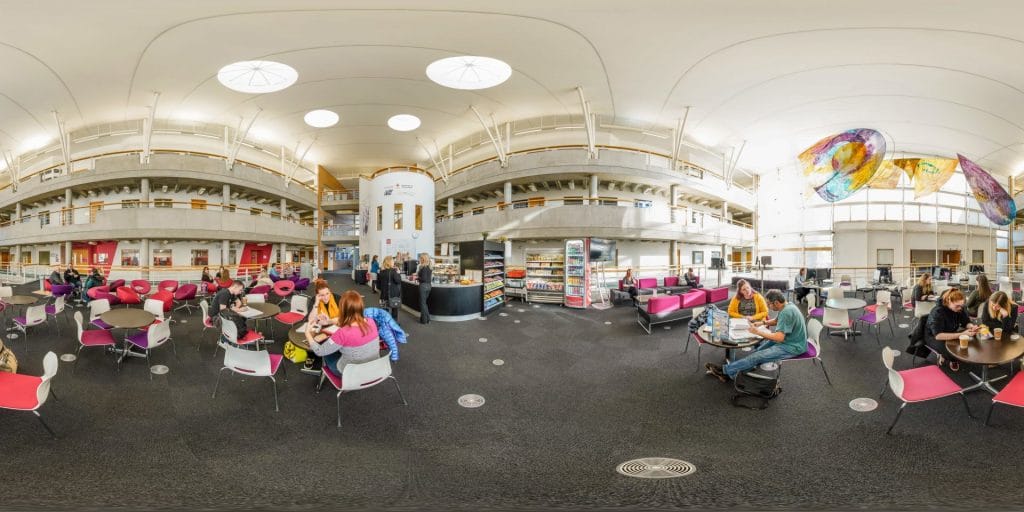Why you need to be using 360° images in your marketing, why viewers like them so much and how to get a room ready to take one.
If a picture says a thousand words, how much is a 360° image saying? Well to be honest: a lot more. Remember when Joey got inside the map in Friends? It’s that for photos. I’ve been a photographer at RV for 11 years and in that time we’ve developed our skills and launched a range of new products. We’ve come a long way from the early days when I worked on a B&B shoot where we accepted bacon sandwiches as part payment…
One of our big areas of growth has been 360° photography because the images have gone down so well with audiences. 360s get the viewer right into the heart of a scene so they have a completely immersive experience of viewing and they can explore everything in loads of detail. If you’d like an example, how about getting to know the food and drink options at the University of Sunderland? It feels a lot more real than viewing static images of cafes, doesn’t it?
In a 360 the viewer gets to focus on their own area of interest
Image composition is usually an important part of photography but 360s differ because the photo literally captures everything (often on shoots, clients ask me which bits of a room we will focus on and I have to remind them we are doing the whole thing…). Audiences have complete freedom over what they want to look at which is great because they are led straight to what interests them best, rather than what the photographer is wanting to direct their interest towards. Dwell times on 360s are much longer than on stills, probably both for that reason and because the interactive element of ‘showing themselves around’ keeps people interested for longer.
Audiences prefer 360s to stills
In the past few years, RV have been doing more market research (taking us ever further from the ‘bacon sandwich’ era) so we’ve got more data to back up what we know from our experience. We’ve been running focus groups for the past five years, and we recently spoke to groups of prospective and current university students where we found that every group preferred 360° photography. Compared with stills, they said 360 was more authentic, clearer and more informative. This research related to Higher Education but of course the sentiment can be applied to nearly every other sector. The fact is that it is more engaging to allow your viewer to be at the heart of an image and to be able to interact with and explore a picture.
Audiences trust 360s more than stills
I’ve picked up quite a bit of informal feedback on the perception of 360s versus stills while I’m shooting and chatting to clients and their colleagues. Interestingly, the majority of people I’ve met think that a 360° image is related to video rather than photo – and as a result, they trust 360s more than they do still images. People can be a bit suspicious of marketing images and are very well-informed about how much a picture can be Photoshopped but they are often not aware that this level of editing is also possible in a 360, so they consider these images to be more authentic. Marketing departments like them because it’s good to know you’re reaching audiences with authentic content rather than content they are going to take with a pinch of salt!

The best 360s are of uncluttered, tidy spaces
There’s nowhere to hide with a 360 and since I’ve been shooting them, bins and coats have become my nemesis! They are always the things that are in the way and making an image look messy. It’s okay to spruce up an area before a 360 – of course we want to give the audience a genuine representation of what a space is like – but that doesn’t mean we can’t put a room’s best foot forward! I usually advise clients on what we could move (bins and coats – see above. MY NEMESIS!) and the kind of clutter that accumulates in a well-used lab. With homebuilder, the spaces are usually dressed for the occasion so it’s a bit more straightforward. Clients choose whether they’d like people in the rooms or not – I think for universities it’s best to include them as a bit of activity brings the space to life. Homebuilder is a bit different – it can work either way.
You can use 360s to create immersive virtual tours
Once you’ve got a few 360s, you can combine them to create a virtual tour so viewers get to show themselves around a house rather than just a room, or a full university campus rather than one single area. In this Hull University tour, viewers start outside but can then get a good sense of space and place by going inside different buildings and ‘walking’ to different areas.
